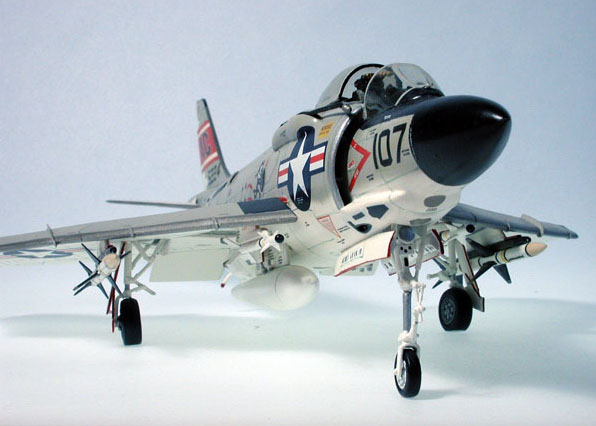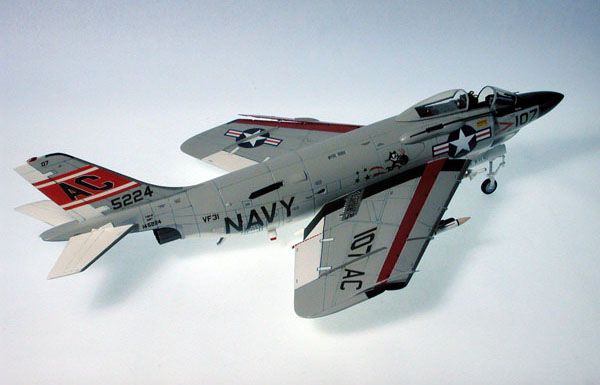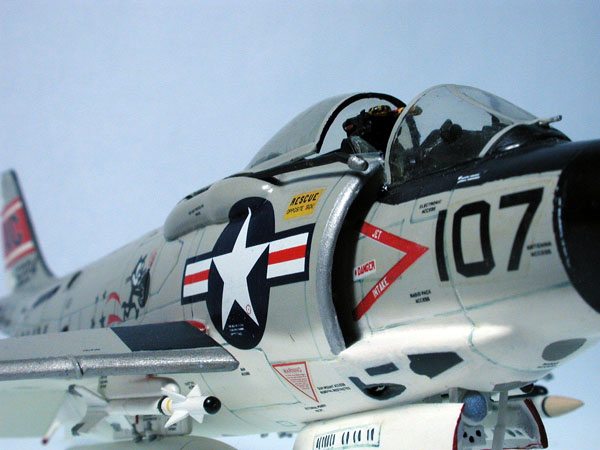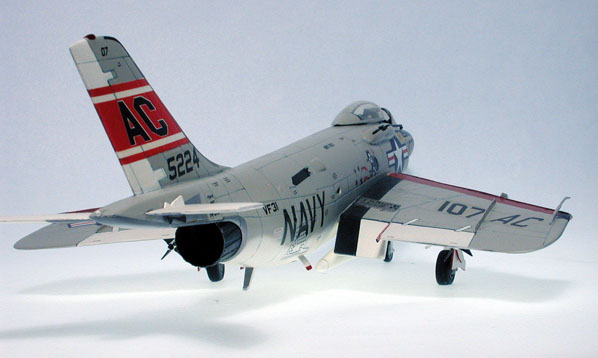|
McDonnell
F3H-2 Demon
by
Phil Brandt
|

|
|
McDonnell F3H-2 Demon |
images
by Milton Bell

HyperScale is proudly sponsored by Squadron
The McDonnell F3H-2 Demon shared the unfortunate fate of an entire
late Fifties/early Sixties generation of pace-setting Navy fighter
designs doomed to short operational lives by the failure of Westinghouse
jet engines to produce promised thrust and reliability.
The extremely poor reputation of these powerplants resulted in
Westinghouse abandoning the aircraft engine business, but although the
Demon soldiered on only 'til 1964 with the replacement J-71 engine, the
airframe's design concepts were already evolving into what would soon be
the fighter standard of the world for the next twenty years, the F-4.
The absence of a quality 1/48 Demon--the vac Comet "whip
model" doesn't count, and the Collect-Aire resin kit was released
later than our subject kit--was, until about five years ago, a glaring
gap in U.S. Naval aircraft between WWII and Vietnam. Accordingly, Bondo
was ecstatic when Golden Wings in the U.K. came to the rescue with a
very nice multimedia release; saved again by vacuform!

Molding is quite decent, akin to that of Aeroclub, albeit with
relatively thin plastic. Engraving is less delicate than, say,
Dynavector, but still acceptable. White metal parts were numerous, and
also of acceptable, if plain, quality. Fate smiled further when Eagles
Talon announced a most helpful $27 resin detail set for the Demon,
including the cockpit, seat, afterburner nozzle and air refueling pod
and boom.
I was dissatisfied with the shape of the vac radome and substituted
one from a spare F-4C/D kit. The kit's metal burner nozzle was too
small, and the resin one from Eagles Talon bit the dust also, in favor
of, again, a larger one from an F-4 kit.
Although the sawtooth-edged, perforated spoilers are molded into the
wing, I didn't care to conduct a 'practice bleeding' session to
painstakingly remove those sawtooth edges and do all the necessary
detailing to display the spoilers deployed. Even so, their steel
metallic finish helps to contrast with the large expanse of gull gray.
In retrospect, I do wish I had taken time to cut out and detail the
speedbrakes. I guess I was just too tired to have to punch all those air
holes!

Scratchbuilt details were also added. Slats were cut out of the wing
leading edges, and the slat nesting area created out of F-111 wing
leading edges. One reason I like to do slats on this era of naval birds
is not only for the "busy-ness" factor, but also for the great
color contrast between the red undersurfaces and the gull gray/white
overall scheme. Flaps were dropped, antennas, dump masts added and the
structural area behind the seat detailed per drawings and pix in the
excellent--virtually a requirement when doing older navy
birds--"Naval Fighter" Demon volume by Steve Ginter.
Markings
and Finishing Touches
|
Unit markings are from the Golden Wings decal sheet and are those of
the famous VF 31, "Felix the Cat." National insignia was from
a Superscale sheet, as are various stencils.

The landing gear was done OOB, with the only caveat being that the
soft white metal flat strut portion onto which the main gear axles are
molded tends to bend with the passage of time, making the wheels slowly
assume negative camber. I've had to bend 'em back numerous times, and
I'm afraid they'll soon 'work harden' and break.
Although Bondo is a retired recce/Vark "puke," I've always
been enchanted with older generations of naval fighters, especially so
with the Demon. I am therefore so grateful that there are small firms
out there willing to take the road less travelled while the Tamiyagawa
Empire bean counters consider which Me-109 version to do next.
Bondo Phil IPMS 14091
Click the thumbnails below to view
the images full-sized.
Use the "Back" arrow of your browser to return to this page.


Model and Text Copyright ©
2001 by Phil Brandt
Images Copyright ©
2001 by Milton Bell
Page Created 08 May, 2001
Last Updated 04 June, 2007
Back to HyperScale
Main Page
Back to Features Index
|
Home
| What's New |
Features |
Gallery |
Reviews |
Reference |
Forum |
Search